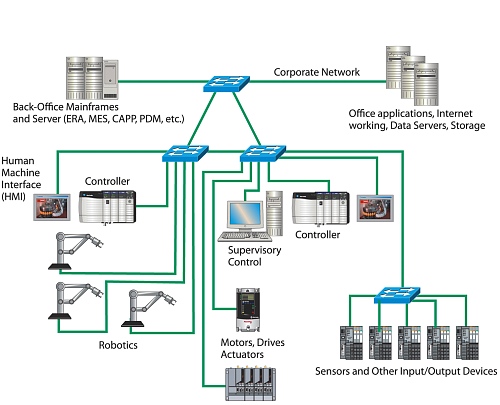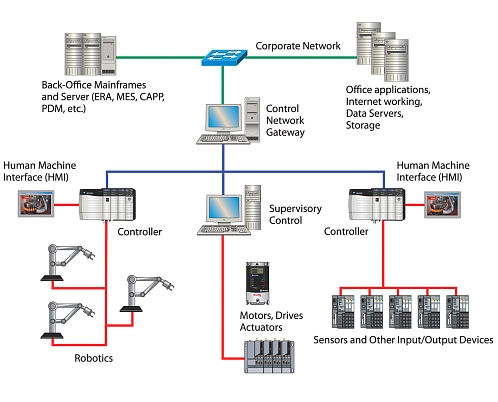
Ether-networking: How Ethernet links the manufacturing environment with the enterprise level
November 26, 2009
By Mike Hannah
Ethernet has been the de facto standard for business enterprise systems for many years, and the industry adoption of EtherNet/IP for control and information has enabled of network convergence between manufacturing and enterprise networks.

 Converging technologies between traditional information technology (IT) systems and manufacturing operations provides manufacturers with opportunities to reduce risk and costs, provide secure information access, and improve agility and overall business performance. By getting real-time information at the right time and at the right levels, they can take advantage of network convergence.
Converging technologies between traditional information technology (IT) systems and manufacturing operations provides manufacturers with opportunities to reduce risk and costs, provide secure information access, and improve agility and overall business performance. By getting real-time information at the right time and at the right levels, they can take advantage of network convergence.
Industrial Ethernet links the manufacturing environment with the enterprise level, helping enable migration from the traditional three-tier network model to a converged Ethernet model (as shown on page 11). To assist manufacturers in successful migration to this model, ODVA, with support from other manufacturing industry leaders, began promoting a Common Industrial Protocol (CIP) to keep Ethernet standard and unmodified, and thus help integrate the plant floor and enterprise.
The Common Industrial Protocol
Traditional three-tier networks were designed and optimized for performance in specific applications, most commonly in device, control, information, motion and safety. Although well suited for their designated functionality, they were not developed with a single architecture in mind. Manufacturers were forced to use many specialized and often incompatible networks across their plant to meet their production requirements. Providing real-time data between the different networks became difficult, if not impossible, for manufacturing engineers to manage.
To take full advantage, convergence requires seamless integration throughout a manufacturer’s enterprise. Open systems connected these disparate systems together but have not yet lived up to expectations. Integrating different systems and protocols required gateways, extra configuration and programming yet still achieved limited functionality. As a result, manufacturers had limited success reaching the productivity and quality benefits they were hoping for from open systems and had to compromise on their investments.
Common application layers help solve the interoperability problem by creating integrated communication networks. The CIP networks — including DeviceNet, ControlNet and EtherNet/IP — share the CIP at their upper levels while remaining media independent at their lower levels. This allows manufacturers to specify the best network for their application, eliminating complex gateways when connecting dissimilar upper-level networks. Model networks, such as EtherNet/IP, play a key role in successfully deploying a converged Ethernet manufacturing network.
EtherNet/IP is a CIP adaptation of TCP/IP that fully utilizes the standard IEEE 802.3 Ethernet physical layer and supports both TCP and UDP at the transport layer. This TCP/UDP/IP approach provides real-time technology in the Ethernet domain. With the network extensions of CIP Safety, CIP Sync and CIP Motion, CIP networks allow for safety communication, time synchronization, and simple to high-performance motion all over the same EtherNet/IP network. In addition, Ethernet users can take advantage of commercial, off-the-shelf Ethernet hardware and standardize on network architectures fully compatible with TCP/IP and UDP/IP.
Safety
Like other digital safety protocols using a “black channel” approach, CIP Safety is an extension to the application layer. It provides a set of highly integrated safety services that leverage the underlying communications stacks of the standard CIP networks to transport data from a source to a destination. It is certified compliant with the functional safety standard IEC 61508 up to safety integrity level (SIL) 3.
CIP Safety’s end-to-end protocol gives responsibility for ensuring safety to the end nodes rather than the bridges, routers or intermediate nodes. If an error occurs during data transmission or in the intermediate router, the end device will detect the failure and take the appropriate action. Since the safety coding and not the underlying communication layers ensure data integrity, the underlying communication layers can be interchanged and intermixed even across subnets. CIP Safety allows users to mix standard and safety devices on the same open network.
Time synchronization
Use of time in a control system generally is applied to time-stamping applications and frequency-based applications. CIP Sync is a time-synchronization extension based on the IEEE 1588 (IEC 61588) standard — Precision Clock Synchronization Protocol for Networked Measurement and Control Systems — commonly referred to as the Precision Time Protocol (PTP). PTP provides a standard mechanism for distributing Coordinated Universal Time (UTC) across a standard Ethernet network of distributed devices. By time stamping in UTC, events can easily be compared across time zones without having to be adjusted for geographic origination.
CIP Sync allows users to base control on true time synchronization rather than the limited event synchronization model used historically. Using a 100-megabits-per-second switched Ethernet system, advanced testing shows CIP Sync can deliver time-synchronization accuracy of less than 500 nanoseconds between devices, meeting some of the most demanding real-time applications’ requirements.
Distributed motion control
Integrated motion on EtherNet/IP uses CIP Motion technology to combine the requirements of deterministic real-time motion control applications with standard, unmodified Ethernet providing full compliance with the Ethernet standards IEEE 802.3 and TCP/IP. This allows the use of standard Ethernet components and infrastructure without special switches or gateways. CIP Motion accomplishes this with a set of application profiles designed to allow users to set position, speed and torque loops in the drive. With CIP Sync technology, multiple axes can be coordinated for precise, coordinated applications.
Using time-stamped data and a simple timing model eliminates hard synchronization constraints between the drive and the controller. Real-time data values are adjusted at the end device when the data is applied with no need to hard schedule the network traffic. In addition, CIP Motion enables the same network connection to be used for a high-performance servo drive with precise synchronization requirements and a low-performance Volts/Hertz drive with no time synchronization capability.
Reference architectures for manufacturing
As we said, Ethernet has been the standard for business enterprise systems for many years. However, information or data access from anywhere at any time presents new challenges. The need to protect assets from both internal and external threats is important to consider, and therefore the design and deployment of a robust, secure network infrastructure has caused some unclear demarcations between manufacturing and IT professionals.
To help bridge the gap between these groups, Rockwell Automation and Cisco are working together to deliver design guidance through Converged Plantwide Ethernet Architectures. These resources provide education, design guidance, recommendations and best practices to help establish a robust and secure network infrastructure.
Built on technology and manufacturing standards common between IT and manufacturing, Converged Plantwide Ethernet Architectures follow standards, such as IEEE 802.3 Ethernet, Internet Engineer Task Force (IETF), Internet Protocol (IP) and CIP. This design guidance creates a foundation for network segmentation for network management and policy enforcement, such as security, remote access and Quality of Service (QoS). The joint architectures follow standards such as ISA-95 Enterprise-Control System Integration, ISA-99 Manufacturing and Control Systems Security, and the Purdue Reference Model for Control Hierarchy.
The convergence of manufacturing and enterprise networks increases access to manufacturing data, helping manufacturers make more informed decisions. They recognize that to achieve their business objectives and be competitive in a global environment, their organizations need to get this data to the right people, at the right time. CIP allows complete integration of control with information, multiple CIP networks and standard Internet technologies.It also provides manufacturers with a scalable and coherent architecture incorporating discrete, process, safety, synchronization and motion applications using the same network technology as the ERP, MES enterprise levels applications.
Similar solutions are available from other industrial protocols, such as Profibus, and under development by Fieldbus Foundation. Ultimately, network convergence helps align technology with business goals for business process transformation and enterprise-wide visibility.
Mike Hannah is a product business manager for NetLinx with Rockwell Automation.
Advertisement
- Emerson wireless transmitters monitor gas plants in Argentina
- Reader’s response: True convergence must include a PC